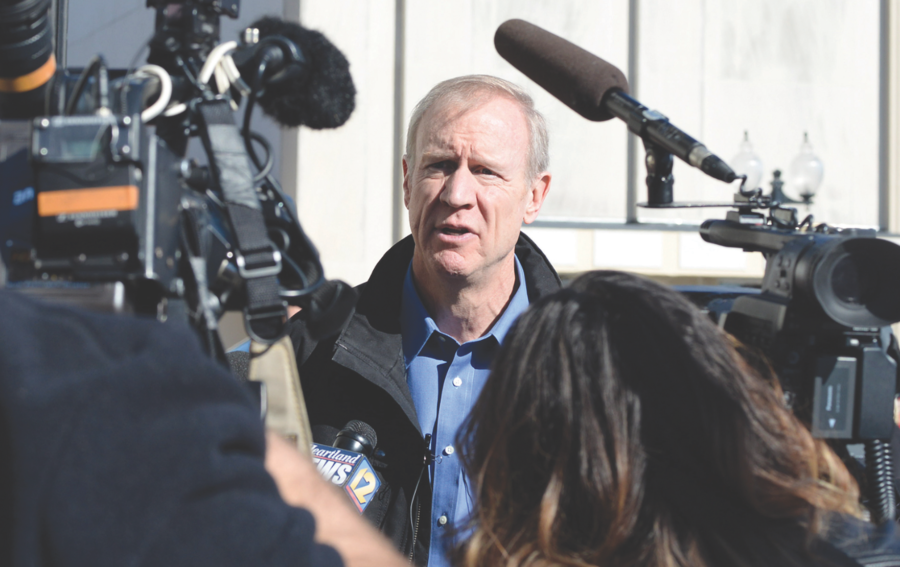Illinois House considers stopgap budget, education funding measure amid hope for deal
June 30, 2016
The Illinois House on Thursday is considering on a stopgap budget that would keep state government afloat for six months, ensure schools open this fall and provide help to struggling Chicago Public Schools after Republican Gov. Bruce Rauner and Democrats who control the General Assembly hoped they struck a deal amid intense political pressure with the November election looming.
The package of bills follows two days of closed-door negotiations, the first meaningful round of give-and-take on the budget as the state faced entering a second straight year without a full spending plan come Friday.
Without a temporary budget in place, schools face the possibility of not opening this fall, thousands of construction workers may spend the summer off the job, and the state’s unraveling network of social service programs faces further decimation.
Advertisement
“I suspect the reality is everybody wanted to get some place and get us on the road to solving these problems. So I think the governor was very anxious to have a program in place to fund public education, so was everybody else,” said Rep. Barbara Flynn Currie, a Chicago Democrat and top lieutenant of House Speaker Michael Madigan. “So I think there was pressure everywhere you looked to do something, and I think this is that something.”
Even so, critics contend the temporary agreement is not enough. They argued it would only exacerbate the state’s financial problems down the road, saying it does little to address underlying issues that drive the cost of government and was more about saving face with voters.
House lawmakers approved several secondary budget bills, then huddled in private before the key vote on a stopgap budget and education funding.
Under the plan, the state would spend an additional $250 million on schools, which would be doled out based on the number of high-poverty students in each district. As it stands, CPS would get roughly $100 million. The district, which has a huge budget deficit, had faced a reduction of state aid under the current school funding formula.
Mayor Rahm Emanuel and the Chicago Board of Education would be allowed to restore a property tax levy dedicated to pay teacher pensions, which Currie said could bring in an additional $250 million for the district. Meanwhile, the state would agree to pick up roughly $200 million in teacher pension payments, a provision that would only be good for one year starting next June. But Republican lawmakers said the legislation wouldn’t be sent to Rauner as the General Assembly and administration work on a broader agreement to cut costs in the state’s woefully underfunded employee pension system.
Emanuel offered no specifics about how the measures would affect Chicago taxpayers. While speaking at a summer learning event in Bronzeville, the mayor said the agreement is fair and will keep CPS cuts out of classrooms.
“First of all, I would say to both our parents, our principals, our teachers and our students, obviously the last six months have worn on people’s patience given all the uncertainty with what was happening in Springfield with finances,” he said. “And the good news is, I think that uncertainty and the wear and tear on people’s patience is about to come to an end.”
Advertisement*
“We’ve worked hard over the years to keep the financial pressure away from the classroom,” he added. “And if the agreement is successful, I happen to think its a fair agreement that will allow us, for a fifth year, to keep the finances, or financial challenges of CPS, we will get those right and do it in a way that doesn’t undermine all the educational success and gains that we’re seeing in our schools from the months of the fall to the early days of the summer. And so, been hard at work in this effort.
The mayor said he has been working to help close the deal and would continue to do so Thursday.
“What I do know about the legislative process, I don’t count any chickens before they’re hatched, so I’m going to get back on the phone and do, you can tell by my voice, do my work as mayor to help secure the effort,” he said.
Meanwhile, one bill in the budget package that would authorize new tax increment financing districts for Chicago to help pay for mass transit projects irked some lawmakers, who argued it was hastily put together without enough transparency.
“Where were the hearings? Where are the promises? Where is the language in the bill…to be sure that the right things are being done?” asked Rep. Al Riley, an Olympia Fields Democrat, who referred to the proposal as a “super TIF” because it would run for 35 years rather than the standard 23 years.
Currie responded that the bill is “critical” in order to allow the city to tap into more than $800 million in federal funds that could be used for transit projects. The bill passed.
The stopgap spending portion of the plan would release billions of dollars to cover expenses that have gone unpaid the past year and includes some funding for the first six months of the new budget year that begins Friday. The money isn’t enough to pay those expenses in full, but it will allow the government to start paying down debts owed to social service providers, keep roadwork projects on track, continue to keep prisoners fed and state vehicles fueled, and provide a much-needed cash infusion to universities.
The bill releases $670 million to pay for social services, which amounts to about 65 percent of the cost of those services from last July through the end of this year. Providers of immigration services, autism services and youth programs, which had been frozen out of state spending over the last 12 months, would become eligible for payments under the plan. It was still unclear, however, how payments to social service providers would be prioritized, given that the money isn’t enough to cover all of their bills.
The Rauner administration would get $720 million to cover costs at state facilities for utilities, food, medical care, gas and repairs to the state’s vehicle fleet. About $1 billion would be funneled to the state’s higher education system, with about $655 million going to the nine state universities, $114 million going to community colleges including City Colleges of Chicago, and $151 million to cover tuition grants for low-income students that were promised last year but never paid.
Much of the spending would be paid for by sweeping money from special funds, including forgiving $454 million that the Rauner administration borrowed from other funds last year.
And as they have done in past years, lawmakers will forgo their annual cost-of-living raise.
Byrne reported from Chicago.
(c)2016 the Chicago Tribune
Visit the Chicago Tribune at www.chicagotribune.com
Distributed by Tribune Content Agency, LLC.
Advertisement








